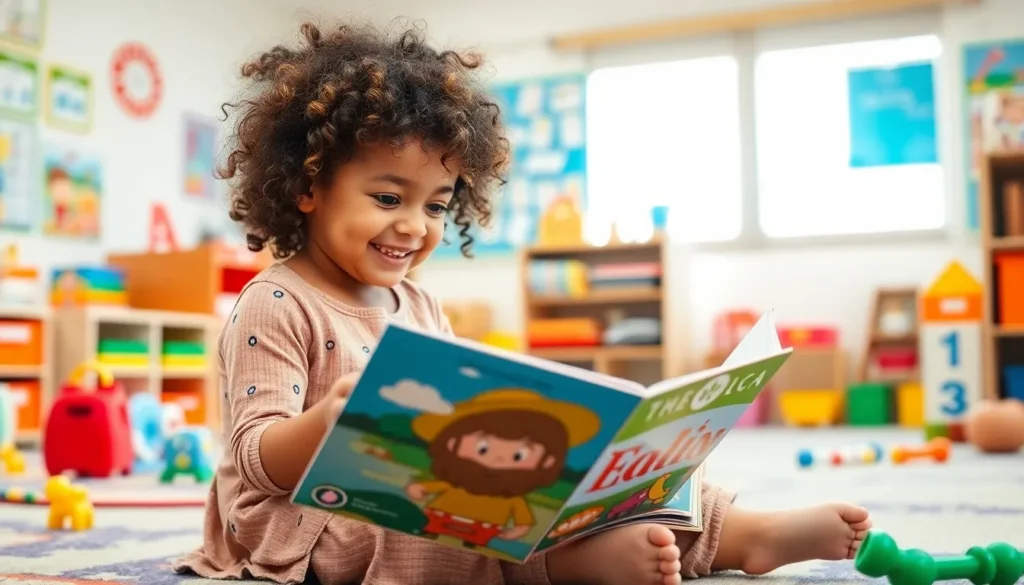Table of Contents
ToggleIn a world where toddlers can navigate smartphones better than most adults, the importance of child language education has never been clearer. It’s not just about teaching kids to say “please” and “thank you.” It’s about equipping them with the tools to express their thoughts, emotions, and wild imaginations. After all, who wouldn’t want their little one to articulate their love for broccoli or passionately debate the merits of dinosaurs over unicorns?
Effective language education lays the foundation for lifelong communication skills. It opens doors to friendships, academic success, and even the occasional epic debate about the best superhero. So, whether it’s through playful conversations or engaging storytelling, nurturing language skills in children is crucial. Let’s dive into the delightful world of child language education and discover how to turn those tiny babbles into powerful words.
Overview of Child Language Education
Child language education plays a pivotal role in early development. This education encompasses various approaches designed to enhance communication skills. Key elements include vocabulary acquisition, syntax understanding, and pronunciation practice. Engaging activities often involve storytelling, music, and interactive games, promoting a love for language.
Interactive reading fosters cognitive growth, helping children comprehend story structures. Speaking with peers encourages turn-taking and active listening, which are crucial for social interactions. Specialized programs utilize techniques tailored to different age groups, focusing on their specific developmental needs. Language education doesn’t just support academics but also nurtures emotional intelligence.
Teachers and parents contribute significantly by modeling effective communication. Through consistent encouragement, they can help children articulate thoughts clearly and confidently. Research indicates that exposure to rich language environments positively affects literacy and overall academic performance. Structured curricula often incorporate both written and spoken components, ensuring a holistic approach to language learning.
Customization enhances engagement, addressing individual learning styles and preferences. Resources such as apps and educational toys have emerged, bridging traditional methods with modern technology. This integration provides children with diverse avenues to explore language, fostering creativity and expression.
Through meaningful interactions, children build foundational skills necessary for lifelong learning. Language education ultimately equips them with the tools to navigate an increasingly complex world, strengthening their ability to connect with others.
Importance of Early Language Development

Early language development plays a crucial role in a child’s overall growth. Fostering communication skills at a young age helps children engage with their world effectively.
Cognitive Benefits
Cognitive development significantly improves with early exposure to language-rich environments. Language acquisition enhances vocabulary, facilitating stronger reasoning and problem-solving skills. Children who learn to articulate their thoughts clearly demonstrate better comprehension in academic settings. Engaging with words during formative years builds neural connections that support intellectual growth. Additionally, playful interactions utilizing language boost critical thinking abilities and creativity. Structured conversations, whether through reading or play, strengthen the mental frameworks necessary for lifelong learning.
Social and Emotional Advantages
Social skills flourish when children develop language proficiency early. Effective communication fosters friendships, enabling children to express feelings and navigate social dynamics. During peer interactions, kids learn essential skills like turn-taking and empathy. These experiences lay the foundation for healthy relationships and emotional intelligence. Moreover, children gain confidence when they articulate their thoughts, which enhances self-esteem. Encouragement from parents and educators can further nurture these skills, creating a supportive environment for emotional development. Overall, early language development nurtures both social competence and emotional well-being.
Techniques in Child Language Education
Effective techniques in child language education enhance communication skills and foster cognitive development. Engaging methods create enriching environments for children to develop linguistic abilities.
Play-Based Learning
Play-based learning encourages natural language development through interactive engagement. Children learn vocabulary and syntax while participating in games and creative activities. Incorporating educational toys and games stimulates curiosity and motivation. For example, role-playing activities allow children to experiment with new words in context. As kids navigate scenarios, they practice language skills in a vibrant, low-pressure setting. Additionally, play promotes collaboration and negotiation, enhancing social skills and turn-taking. This method not only nurtures expression but also strengthens emotional intelligence.
Interactive Storytelling
Interactive storytelling captivates children’s imagination while promoting language skills. Involving children in storytelling allows them to contribute ideas and ask questions. This approach enhances comprehension and encourages active participation. When adults encourage children to predict outcomes or describe characters, they facilitate cognitive engagement. Engaging with stories fosters vocabulary growth and instills a love for reading. Moreover, discussing story themes helps children articulate their thoughts and feelings. By connecting narratives to real-life experiences, storytelling deepens understanding and promotes critical thinking. Overall, interactive storytelling fosters a rich language environment and strengthens communication skills.
Challenges in Child Language Education
Child language education faces various challenges impacting effective learning. Addressing these issues is essential for fostering language development in all children.
Socioeconomic Factors
Socioeconomic factors significantly influence access to quality language education. Limited resources often restrict exposure to rich language environments. Families in low-income areas may lack access to books, educational toys, and interactive learning experiences. Additionally, parents working multiple jobs might struggle to engage in meaningful conversations with their children. Consequently, this lack of interaction can impede vocabulary growth and overall language skills. Research shows that children from affluent backgrounds typically demonstrate stronger language abilities due to richer home environments. Awareness and initiatives aimed at leveling the playing field can help close this gap.
Special Needs Considerations
Special needs considerations play a vital role in child language education. Each child has unique learning needs that affect their language acquisition processes. Tailored interventions and individualized education plans can support children with speech or language disorders. Collaboration among educators, speech therapists, and families ensures consistent reinforcement of language skills. Various approaches, such as visual aids and multisensory techniques, cater to diverse learning preferences. Early identification of specific challenges allows for timely interventions, promoting effective communication skills. With appropriate resources, children with special needs can thrive in their language learning journey.
Future Trends in Child Language Education
Innovative trends are shaping child language education to meet the needs of evolving learning environments. Educators increasingly focus on technology and multilingual education approaches to enhance language acquisition.
Technology Integration
Incorporating technology into child language education captures children’s attention. Tools like educational apps and interactive platforms provide engaging experiences. Mobile applications often combine games with language exercises, proving effective in vocabulary development. Virtual and augmented realities enhance immersive storytelling, promoting comprehension and retention. Using technology fosters collaboration among peers, allowing for dynamic interactions and peer learning.
Multilingual Education Approaches
Embracing multilingual education supports cognitive flexibility in children. Programs designed to expose children to multiple languages from an early age yield benefits in problem-solving and creativity. Instruction in various languages develops cultural awareness and promotes inclusivity. Research shows that bilingualism enhances cognitive abilities, improving overall academic performance. Schools increasingly adopt dual-language models to create enriching environments for language learning.
Child language education is vital for fostering a child’s overall development in today’s fast-paced world. By creating rich language environments and engaging in interactive activities, parents and educators can significantly enhance children’s communication skills. These skills are not just about mastering vocabulary but also about building emotional intelligence and social connections.
Embracing innovative approaches and technology can further enrich the learning experience. As children navigate their educational journeys, the foundation laid through effective language education will empower them to express themselves confidently and connect meaningfully with others. Investing in language development now is an investment in a child’s future success and well-being.




